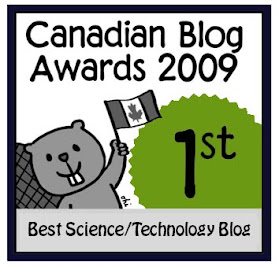 There’s quite a bit of hullabaloo (I can’t believe I just used that word) surrounding the recent creation of the first “man-made” synthetic cell. Genomics, the study of DNA sequences of entire organisms, has come a long way in a very short time: after all, Watson and Crick discovered the structure of DNA less than 60 years ago, and already we’re toying with the thing like it’s silly putty.
There’s quite a bit of hullabaloo (I can’t believe I just used that word) surrounding the recent creation of the first “man-made” synthetic cell. Genomics, the study of DNA sequences of entire organisms, has come a long way in a very short time: after all, Watson and Crick discovered the structure of DNA less than 60 years ago, and already we’re toying with the thing like it’s silly putty.DNA can be thought of as the recipe book to make an organism. In your DNA, there is all the information necessary to make every single part of your body. Strangely enough, DNA is only made out of four units: A, C, T and G (remember the movie “Gattaca”? That’s a play on a DNA sequence). The sequence of these units determines your genes (small chunks of DNA), your chromosomes (larger chunks of DNA comprised of many genes), and your genome (the sum of all your DNA). To create the synthetic cell, the researchers started with the genome of one bacteria (let’s call it “donor”). They mapped out the genome of the donor into a computer file, and then edited the code, adding a few specific chunks here and there. These added chunks (the “watermarks”) would later serve as markers to confirm that the resulting organism only hosts the synthetic code. Once the researchers had a DNA sequence they were happy with, they fed the code into a machine that spurts out the As, Cs, Ts and Gs in the correct order and generates small pieces of synthetic DNA. The researchers then used elaborate techniques to stitch together the small pieces into a complete genome. Finally, the researchers transplanted this synthetic genome into a different bacteria (the “recipient”) previously emptied of its own genome. Shazam! Synthetic “life”.
At this point, I don’t think we can call this breakthrough “artificial life”. Life was not created from scratch. What we have here is a functioning cell (and that includes the ability to replicate) with a synthetic genome. This synthetic genome, even though it was created from a computer, only includes genes found in nature (and the watermarks, but they don’t code for anything). And while it’s fun to imagine that we’re only days away from reviving the woolly mammoth, it’s important to keep in mind that this synthetic cell has a very tiny genome. What’s more, the genome of the synthetic cell had some mistakes in it: it wasn’t exactly as the researchers had intended.
Still, I think there is cause for concern, both in terms of ethics and biodiversity. If we had already cracked open Pandora’s box with transgenic animals and plants, this represents a rip-the-lid-off-and-break-the-hinges advance. Especially considering that current legislation allows the patenting of such organisms (a subject for a later post, perhaps). However, with all the bad comes some hope: like stem cells and gene therapy, this technique may represent a new hope to cure diseases.
What’s your take on this new breakthrough? A step closer to mastering life and curing diseases, or a scary slide down a slippery slope?
Reference: Creation of a bacterial cell controlled by a chemically synthesized genome. (2010) Gibson DG et al. Science, May 20 [Epub ahead of print]




